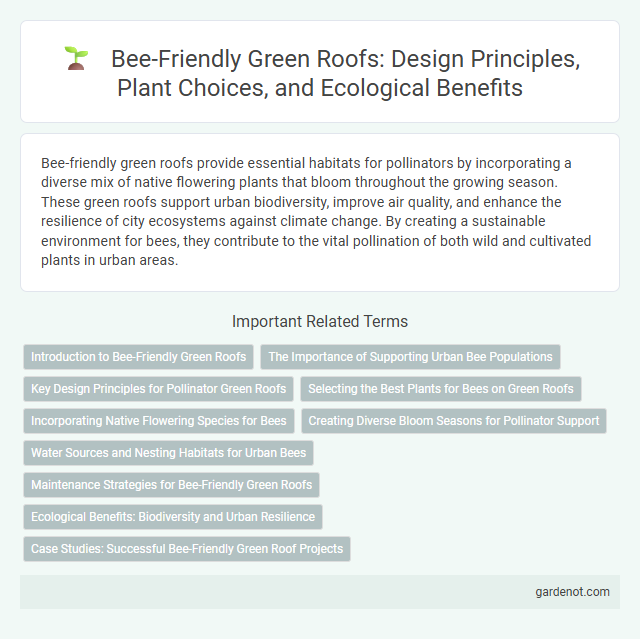Bee-friendly green roofs provide essential habitats for pollinators by incorporating a diverse mix of native flowering plants that bloom throughout the growing season. These green roofs support urban biodiversity, improve air quality, and enhance the resilience of city ecosystems against climate change. By creating a sustainable environment for bees, they contribute to the vital pollination of both wild and cultivated plants in urban areas.
Introduction to Bee-Friendly Green Roofs
Bee-friendly green roofs provide essential habitats for pollinators like honeybees and native bee species, supporting biodiversity in urban environments. These roofs incorporate native flowering plants rich in nectar and pollen, enhancing pollination services while improving air quality and reducing urban heat island effects. Integrating bee-friendly designs also contributes to sustainable city landscapes by fostering ecological balance and promoting environmental resilience.
The Importance of Supporting Urban Bee Populations
Bee-friendly green roofs provide essential habitats that support urban bee populations, crucial for pollination and biodiversity in city environments. These roofs integrate native flowering plants that offer consistent nectar and pollen sources, enhancing bee health and activity. Supporting urban bees through green roofs helps mitigate habitat loss and strengthens food security by promoting urban agriculture and ecosystem resilience.
Key Design Principles for Pollinator Green Roofs
Pollinator green roofs prioritize native flowering plants that bloom sequentially to provide continuous nectar and pollen sources for bees. Structural diversity, including layered vegetation and varied plant heights, enhances habitat suitability and supports diverse pollinator species. Incorporating shallow water sources and unpaved, sunny patches encourages bee activity and nesting opportunities on green roofs.
Selecting the Best Plants for Bees on Green Roofs
Selecting the best plants for bee-friendly green roofs involves prioritizing native wildflowers and herbs such as lavender, coneflower, and thyme, which provide abundant nectar and pollen throughout the growing season. Incorporating diverse flowering species with staggered bloom times supports a continuous food source for various bee species and enhances pollinator habitat. Using drought-tolerant, low-maintenance plants adapted to rooftop microclimates ensures sustainability and resilience of the green roof ecosystem.
Incorporating Native Flowering Species for Bees
Incorporating native flowering species on bee-friendly green roofs creates an essential habitat that supports local pollinator populations by providing nectar and pollen sources suited to their needs. Native plants like purple coneflower, goldenrod, and milkweed offer seasonal blooms that sustain bees throughout their active months. Designing green roofs with these species enhances biodiversity, promotes ecological resilience, and contributes to urban pollination services.
Creating Diverse Bloom Seasons for Pollinator Support
A bee-friendly green roof incorporates a variety of native flowering plants that bloom at different times throughout the growing season, ensuring continuous nectar and pollen sources for pollinators. Plant species such as lavender, coneflowers, and sedum extend bloom periods from spring through fall, enhancing habitat diversity and supporting bee populations year-round. These diverse bloom seasons improve pollinator health, increase biodiversity, and promote sustainable urban ecosystems.
Water Sources and Nesting Habitats for Urban Bees
Bee-friendly green roofs incorporate diverse water sources like shallow basins and misters to ensure reliable hydration for urban pollinators. Nesting habitats are enhanced through the inclusion of undisturbed soil patches, hollow stems, and bee hotels to support solitary and ground-nesting bees. These features collectively sustain healthy bee populations and promote biodiversity in densely built city environments.
Maintenance Strategies for Bee-Friendly Green Roofs
Regular monitoring of flowering plant health and diversity ensures optimal nectar availability for pollinators on bee-friendly green roofs. Implementing organic pest control methods and avoiding chemical pesticides preserves beneficial insect populations while maintaining ecological balance. Scheduled irrigation tailored to the specific needs of native plants promotes robust growth and supports sustained habitat quality for bees.
Ecological Benefits: Biodiversity and Urban Resilience
Bee-friendly green roofs enhance biodiversity by providing vital habitats and forage for pollinators such as native bees and butterflies in urban areas. These ecosystems support urban resilience by improving air quality, reducing heat island effects, and promoting ecological connectivity across fragmented landscapes. Incorporating diverse, native flowering plants maximizes pollinator attraction and ecological services, fostering sustainable urban environments.
Case Studies: Successful Bee-Friendly Green Roof Projects
Case studies of bee-friendly green roof projects reveal significant increases in urban pollinator populations and biodiversity. For example, the Bristol University bee-friendly green roof enhanced native wildflower habitat, resulting in a 40% rise in bee species diversity within two years. Similarly, New York City's Javits Center green roof demonstrated improved pollination rates and supported over 50 native bee species, emphasizing the ecological benefits of integrating pollinator-friendly plants and nesting sites.
Bee-friendly green roof Infographic

 gardenot.com
gardenot.com